2005 Lexus es330 service history
September 14, 2019
1. The original owner was a retired judge in Ottawa who used his Subaru to go to the boat in summer and the Lexus for winter trips to Florida. After four years he took me to the Ottawa Lexus dealership with him to buy his trade-in while he paid cash for a 2009 es350. He and his wife repeated this process twice more for his son and daughter. His widow still claims that the 2005 was the best Lexus of all of them.
Another smug, annoying post
August 6, 2019
The hybrid encourages a whole new attitude toward driving. I have gone from “that jerk in the Porsche passing everything in sight” to “that damned old geezer in the Lexus holding up traffic.”
It’s fun getting to know what uses up the fuel. I have gotten good at making the round trip to Rosebridge at a fuel burn rate of 5.1 L/100 km. That’s with the windows and sunroof open, and the a.c. shut off on the dash.
Today because it was raining I needed the fan for ventilation, but I didn’t want to run the a.c. because of the fuel penalty, so I went into the climate settings and shut the compressor off. The computer showed 4.6 L/100 km. That’s 61 miles per Imperial gallon on the return leg from Rosebridge. Not bad for a 3800 pound car. Almost up to diesel standards.
Real world fuel consumption calculation
July 13, 2019
According to Google Earth it’s 40.2 km from our home to the parking lot of Rosebridge Manor where my mother is a resident. For most of the route there is little traffic, though there are a number of small, restricted-speed hamlets and stop signs.
Tonight with the 2014 Lexus es300h I got 5.2 L/100 km on the drive. That’s 4.1808 litres of regular fuel for the round trip, or $5.35 at the current price at the service station in Toledo of $1.279 per litre.
Fuel consumption rates vary from 5.1 to 5.4 for the trip. This is with air conditioning and headlights off, seat cooler on, windows and sunroof open, fine weather on a summer evening, 80 to 85 km/hr, and using electric power while passing through the hamlets.
On the same route under the same conditions, my 2004 Porsche Cayenne S had a fuel consumption rate of 10.1 L/100 km on premium fuel. The last time I filled this car the rate was $1.399 but that was a couple of months ago.
Marshall challenged me to repeat this test with the Lexus es300h “while driving it like a Porsche.” I obliged on a 33C afternoon, glorying in the air conditioning, even leaving the car for fifteen minutes with the air conditioner (though not the engine) running. I set the cruise control for 100 km/hr instead of 80 and passed on the two-lane roads whenever the opportunity arose. Fuel consumption was 6.4 L/100 km.
Porsche Cayenne factory hitch a potential safety hazard
December 28, 2016
Today I ran into a case where Porsche over-engineering produced a potential safety hazard for the uninformed trailer user.
A Cayenne’s a logical choice to tow a 6X12 covered U-Haul trailer, but not until the rental’s safety chains receive an important modification. The hooks on the trailer I recently rented would not engage the rings on the factory trailer hitch because the steel is too thick to accommodate the triangular safety devices. Jamming the hooks into place wasn’t going to work, so I limped three miles to my shop from the rental depot by a back road. By then, one of the three chains had worked its way loose and was dragging.
I borrowed a pair of hooks from a robust trailer I built a few years ago. The photo shows them in place, pinned into links below the U-Haul hooks. I only had access to two hooks this time but from now on I’ll keep three which I can add on to safety chains to ensure that the robust hitch does not itself produce a hazard.
Update: 29 December, 2016
Grab the chain about 12″ from the hook, stick the CHAIN through the hole, loop the hook around the chain. This worked for me at UHaul.
Another RennList contributor used 3/8″ stainless steel quick-links to do the same job.
According to trailer veteran Tom Stutzman, Toyota has similarly robust hitch dimensions. Pennsylvania mandates simple S-hooks which fit easily. Ontario regulations require the problematic hooks.


Replacing Porsche Cayenne rear door struts: what the You-Tube videos did not tell you
August 29, 2016
There are a couple of decent instructional videos on You-Tube which show the replacement of rear door struts on Porsche Cayennes, but there are some gaps which my assistant and I explored recently on our project car, a 2004 Cayenne named Ruby.
Disassembly:
The videos do a good job on the disassembly process up to the point that you and your screwdriver must work in the dark to release the old struts from the balls onto which they are clipped. The comments which follow may allow the reader to avoid an evening of burnt-fingers thrashing about similar to the one I enjoyed last night.
Don’t bother with the clip which holds the cup onto the forward ball. You can’t reach it. The ball is very sturdy and you won’t be re-using the strut. Pry it off with a large screwdriver and brute force, applied in the direction of the centre of the car, wherever you can find leverage in the restricted area. Yes, that’s an explosive air bag an inch or so to the side of your screwdriver, but the cavity where these struts hang out is good, solid metal.
Once it is released, get into the back seat and reach over the headrest to remove the rear cup. Push or pry it away from the centre of the car. From the back seat with the help of a light you can actually see what you’re doing. Once the strut comes free, push it as far forward as you can, wiggle it to the best possible location to remove it, then persuade it out by compressing it a bit with the large screwdriver levered against the very sturdy sheet metal in this area.
Installing the new struts:
1. My aftermarket struts arrived with both cups on the ends oriented in the same direction. I needed to rotate one of these 180 degrees. This involves the services of a vice and pliers or some other brute-force applicator, as the cups clip on in opposite directions. A little grease on the cups would be a good idea.
2. There is actually a line of sight up to the forward ball from the rear luggage compartment, and you can see well enough to place the strut-end on the ball — as long as it isn’t actually up in the cavity where you must install it. Don’t put it on yet. Once you have forced both ends of the strut into the cavity (which is 1/8″ too short for it) this advantage is lost, but at least you know where it should go.
3. If you’ve put a bit of grease on the cups, the first “click” onto the front ball goes very easily. (Getting it off again is another matter, so don’t experiment too much here.) The second click onto the rear ball (on the other end) can be achieved (from the back seat again) if and only if the rear door is held at the correct height. A piece of scrap lumber from the shop, band-sawn to the contour of the door’s bottom so that it held the door’s lower edge 75 1/4″ from the garage floor, allowed both ends of the strut to pop in without the use of force. There’s enough taper to the bottom edge of the door to allow for some adjustment using this dimension.
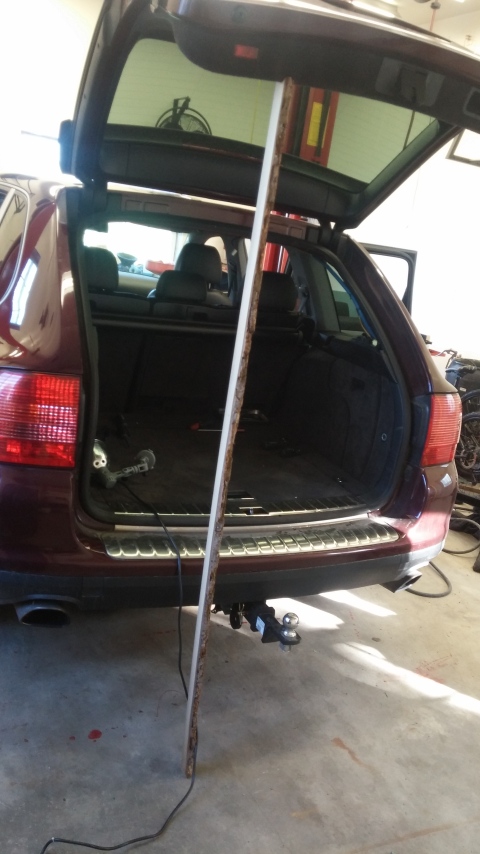
Reassembly: The videos do a good job on most of this, so I’ll just offer a couple of observations.
1. The plastic panels are quite durable. Removing pulled-out clips from the sheet metal slots on the body and re-attaching them to the panels is not a delicate procedure. Just remember those explosive air bags and take your time and be careful to locate all pins and reconnect them to the plastic panels. I kept loose metal parts on a magnetic tray in the hatch with me. You do not want to lose a screw.
2. Those white filler pieces gave me the most trouble, even after I had photographed one to determine its position relative to the panels and the cable before I removed it. HINT: start with the screw the furthest from you. I wasted far too many minutes trying to find its hole after I left it until last.
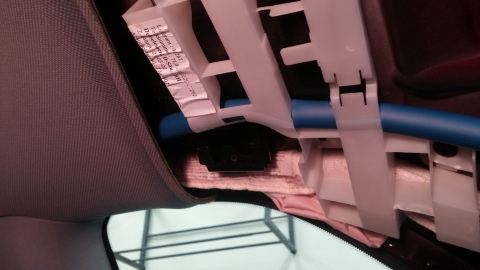
3. Lost speaker wires can be recovered from the luggage compartments below on either side.
4. The trim panel won’t fit properly until you have screwed the tiny torx screw into that safety-screen holder. That tightens the whole thing up. The trailing end of the left side panel on mine decided to act up. There’s a plastic pin on it which refused to reunite with the corresponding hole on the black piece below. A few probes by a 5/8″ woodworking chisel with a view to cutting the pin off (there was none on the right side) resulted in the trim popping into place, so I put the chisel away, recalcitrant pin intact.
The Porsche feeling:
The car is more my own after I have taken it apart and fixed it.
The You-Tube videos gave me the courage to tackle the job. Initially it was a challenge for a non-mechanic, but once I realized that the components are quite durable and there is room for the use of common sense in Porsche repair, it went well.
Parts for Ruby
August 28, 2016
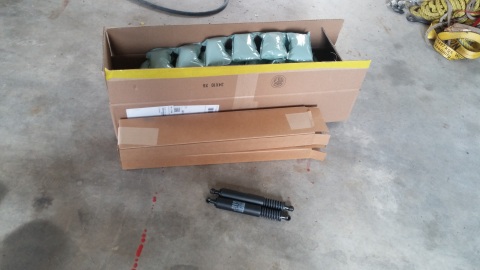
Ruby’s rear hatch only remains up during certain combinations of heat and humidity. Charlie and Roz had held it in place with an umbrella, but I yearned for a wrenching project on the car as far as possible from the oil pump, lest I mess it up.
I acquainted myself with the strut-replacement procedures by watching and rewatching the You-Tube videos and ordered the parts from Amazon.com. They arrived at the Kinek outlet on Wellesley Island, NY, within two days. The price was reasonable, shipping was included, and I really didn’t have anything to complain about.
But does this quantity of packaging for the two small black parts in the foreground look reasonable?
Welcome home, Ruby!
August 17, 2016
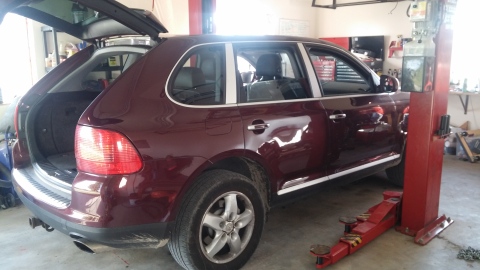
The voice on the phone from Livingston Vehicle Transportation in Vancouver had told me that Invoice #104*77 would arrive on August 15th, at the latest, but I could call back next Friday. She gave me a Montreal number. Surely enough, Ruby arrived on the train over the weekend, but it took until Wednesday morning for her to end up on a truck, destined for Doug’s Towing yard just outside Embrun, to arrive between 10:00 and 12:00. Doug promised me he would call the instant that my Porsche arrived.
At 12:00 I phoned. Doug enthusiastically told me, “They’re just unloading your Cayenne now.”
“I’ll be there in an hour and thirty-eight minutes.”
Our first sight of Ruby was a little pathetic. Some wag had parked it straddling a large mud puddle — real, beige clay, the stuff that sticks to everything. What paint wasn’t spattered from the puddle looked very clean and shiny. It must have had a good ride on the rail car and the truck, but puddles are puddles.
Livingston Vehicle Transportation had done the job well which they had contracted to do.
I made departure arrangements with the genial guy in the office and started Ruby up. As soon as I moved forward an alarm went off: “Parking brake is still on,” or “Release parking brake,” or something. Here I was, stopped in a muddy, crowded parking lot, with very little idea of how to release a stuck parking brake. While I fussed, Bet stepped out of the Lexus and walked toward me holding her phone out. Column after column of “How to free a stuck emergency brake” appeared. Bet had resorted to the Porsche owner’s secret weapon, Google.
Most of the articles suggested worrying the release handle until the problem went away, and so I did, but not before sending a distress text to Charlie. By the time he got back to me I had the car moving properly, but I was too confused about the ventilation system to check for texts.
And it was HOT in this truck. Fortunately the route from Doug’s Towing to Smiths Falls involves a number of short drives across paved concession roads with no traffic — a perfect place for me to sort out the dashboard of a Cayenne. Why do they have two speedometers, two temperature gauges, two range meters (saying different things), and many other switches and buttons I was unable to fathom? And acronyms! Why do Porsche fanciers love acronyms so much?
As I roasted my way through a burnt-fingers exploration of the air conditioning controls, the sight of the Lexus cruising serenely along in front of me, the cool Lexus, chilled seat and all, that stately old gray car looked pretty good to me. The es330 was all about passenger comfort, and its designers did their job well. I can’t say the same for the Cayenne S dashboard controls engineers.
Gradually as I worked my way through all logical combinations of controls and vectoring flaps, I decided to try the counter-intuitive step of punching the icon which looked most like a defroster. Swoosh! Serene air all around me. I wondered if anyone else has tried that before?
I opened the sun roof, but found it was just too hot. I preferred the air conditioning. And to think my initial plan was to buy a Miata.
Incidentally, the Cayenne drove and rode very well, but operator comfort comes first. Performance is well down the list on a first drive.
I stopped for fuel in Smiths Falls and Bet cut for home. Freed of supervision, on the way home Ruby stretched its legs enough to impress me with its power. It will pass on a two lane highway with ease equal to that of the Lexus, but while the Lexus will top out at 110 or 115 km/hr on a typical pass, Ruby must be slowed down from 150 after an equal acceleration interval. This will take some getting used to.
After three and a half hours of driving and trouble shooting, we arrived home exhausted. Ten minutes later Ruby was hauling us to a local restaurant for a meal.
New toy, eh?
Ruby, “railed”: 2004 Porsche Cayenne review #2
August 6, 2016
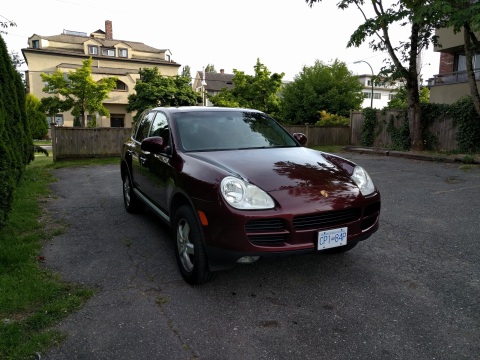
According to the voice on the phone at Livingston, Ruby has now “railed” and should arrive on August 15th at the latest.
Unfortunately Livingston does not offer online tracking on rail shipments. I expressed my regret to her about this, as I enjoy using Google Earth to follow my purchases across North America. It’s a way for a stay-at-home farmer to learn a bit of geography.
The nice lady had no comment on this, apart from a suggestion that I call back next Friday for further details.
My wife and I spent last weekend with the other Cayenne in the stable, the silver one our son used to tow the heavy trailer from Vancouver to Ottawa. Bet loves to drive the thing. There’s no doubt that its handling is a quantum leap ahead of our reliable, but aging Lexus. In fact it was a little terrifying to get back into the Lexus after seat time in the Cayenne. The Porsche is very tight, steers intuitively, treats bumps with derision, and stops with a satisfying brutality. The Lexus’ brakes are a little loose (less drag for improved fuel mileage) and its aging suspension is just fine on smooth pavement, but becomes tentative over uneven city streets. 214,000 km will do that to bushings and shocks. The much younger suspension of the Porsche (122,000 km) makes up considerable ground in ride quality.
On the other hand, three significant advantages allow the Lexus to outclass the Cayenne on a hot-day visit to a nursing home: the es330 passenger seat adjusts to the perfect height for my mother to back up to the rocker panel, sit down on the edge of the unseen seat, and swing her arthritic knees into the car. The Porsche seat adjusts down low enough, but the high bolster on the edge makes a safe landing impossible for Mom. Charlie’s car has optional 19″ wheels while Ruby has 18’s, but I doubt if the Porsche’s bolstered seats will be suitable for expeditions with Grandma.
The other Lexus perk? Front seats are not only heated electronically, they are cooled. Few people like this feature, but Mom and I both enjoy it a lot on a hot day. As I drove the Cayenne, regardless of the quality of its air conditioning, things just got hotter and hotter and my back kept sticking to the leather seat.
Finally there is the issue of fuel consumption. The V6 Lexus has delivered flawless performance on an average of 9.0 litres per 100 km over the last 112,000 km. Charlie’s Cayenne showed 12.5 on the gauge. Mind you, this would have included a cross-country tow with an 8.5 X 20 enclosed trailer, a morning running laps at Mosport Raceway, as well as a life of city driving, but fill-ups with high test are nearly double the cost of those of the Lexus.
It looks as though the Lexus and/or the very economical Scion xB (also with a height-adjustable passenger seat) will remain in the stable for the foreseeable future, though I’m very much looking forward to the day that Ruby de-rails. A Cayenne is simply a gas to drive.
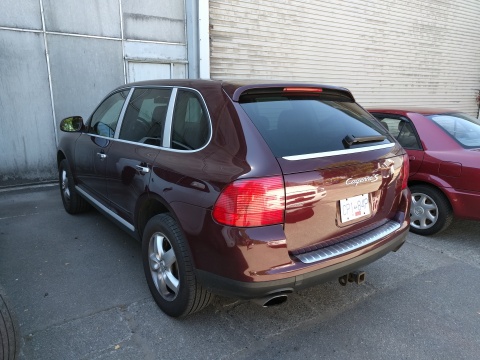
We added the name “Ruby” in anticipation of her arrival in Forfar from Vancouver. If the car acted masculine or nasty, we’d change it to “Jack Ruby,” so the bases were covered.
A few months ago our son had bought a silver 2004 Porsche Cayenne, added a 20′ X 8.5′ enclosed trailer, and towed the contents of their apartment from Vancouver to Ottawa in a little less than 4 days with the help of a co-driver. The following weekend the rig hauled his race car to Mosport for a charity event where the Cayenne even got to run some laps on the big track with loads of kids and their parents aboard.
The car uses an ungodly amount of fuel and eats tires like candy, but functions at a very high level. Impressed, I asked Charlie to pick me up another one, use it for their remaining six weeks in Vancouver, and then ship it to me when they were ready for the airport.
You see, Vancouver is a time warp for automobiles. There is little sunlight and less frost. Most luxury cars live inside out of the rain. Owners take the bus to work to avoid traffic and parking effort. Porsche owners discard their Cayennes after the kids have been delivered to enough soccer games and ski lessons that Mom and Dad can go back to the 911 and a new Panamara, so there is a glut of used Cayennes on the local market.
Today Charlie sent us the photo above, indicating that Ruby should be along in two to three weeks, and that I can call the shipper for location updates.
In the meantime I get to learn about the Porsche Cayenne model from the most reliable source of information and experience I have found, a website called Rennlist.com. It’s where Porsche owners congregate to talk about their cars. From reading the list I’d suggest that Cayenne owners are smart and very good at expressing themselves, though some perhaps don’t have much mechanical experience.
The most recent online mystery I’ve discovered among Porsche owners — no kidding — is whether Cayennes have just one battery under the driver’s seat, or if there’s another under a bass speaker in the cavity in the trunk where there would be a spare tire on any other vehicle. Much speculation fills the pages, though I haven’t heard from anyone yet who has actually severed the rivets which keep us from knowing what lies beneath that strange structure of resonant metal under the rear deck. (January, 2017. Ruby does have a second battery. December, 2017. Charlie’s Cayenne has only one.)
Why did I buy a gas-slurping, driveshaft-shredding, 2 1/2 ton collection of electronic foibles supported by a dealership which takes responsibility for nothing and exacts maximum punishment whenever an owner is forced by circumstance to enter their domain? Did I mention that Cayennes with V8’s cannot sleep outside in the cold or their pistons grind against their cylinders until the engines will no longer run, and there’s no place to attach a block heater? And of course we all know about the plastic coolant tubes through the middle of the engine which get hot, crack, and dump coolant all over the starter. Hey, replacing two sets of coolant tubes should be somewhat easier than just one, and there are lots of videos of the procedure on You Tube.
A couple of years ago I started thinking that a Miata would make a nice toy, but you know how it is with a dream in one’s ebbing years: the options keep piling on. At least a Cayenne can pull a trailer, and the dog will have a place to ride, and it has a roof to protect its occupants from the sun and snow, and all-wheel-drive, and a top speed of 145 miles per hour, just in case I need to hurry.
And as for the mechanical challenges of owning the most notorious Porsche? I’d gotten bored with dead-reliable automobiles, O.K? What else can you do with a Lexus but drive it? My Toyota pickup sits for weeks on end, yet always starts and runs smoothly. A Cayenne can provide all the complexity and aggravation of a Rubik’s cube, and it never even needs to leave the garage.
More later, no doubt. Feel free to comment.
Rod